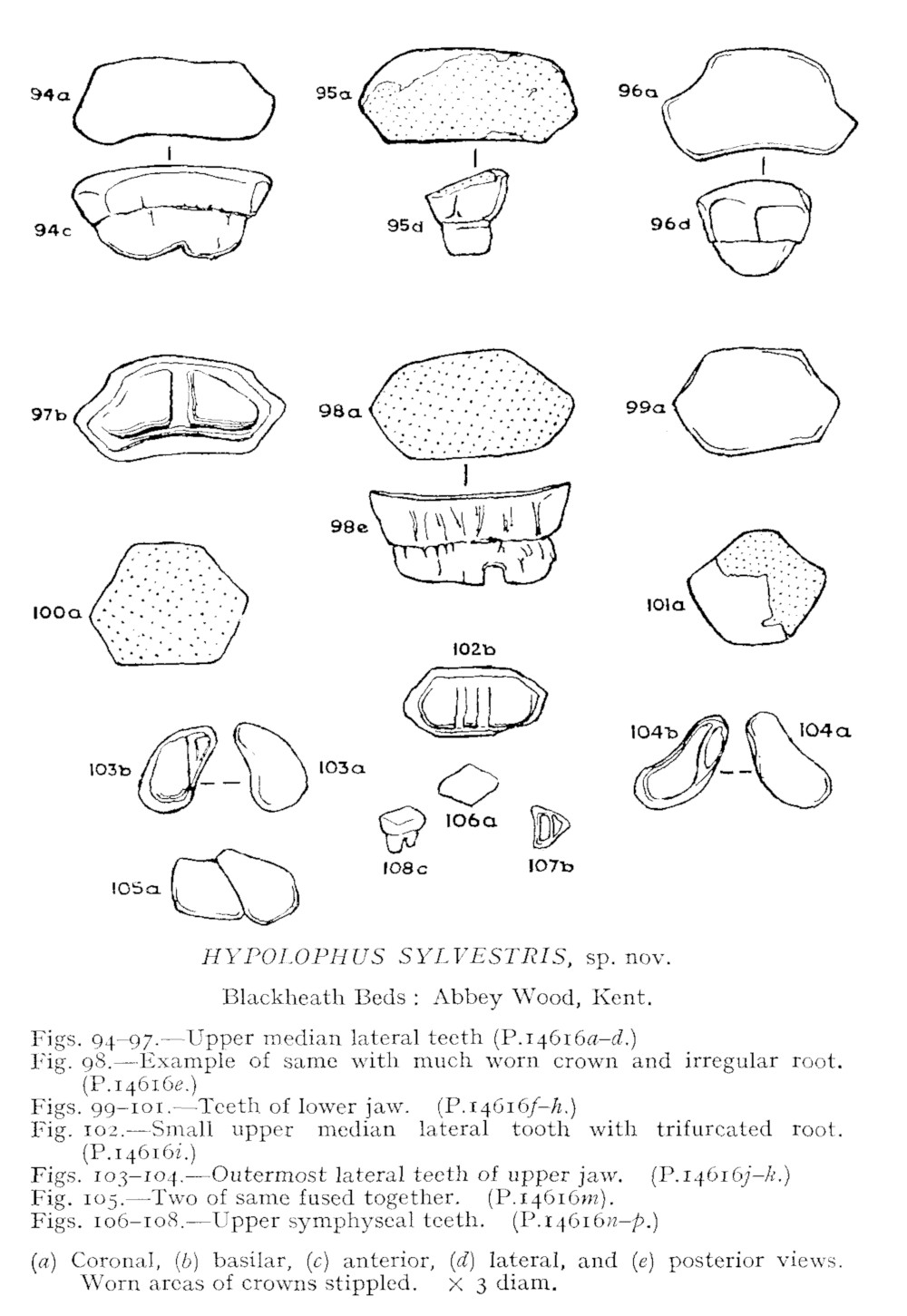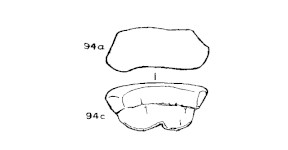Dasyatis sylvestris
(White, 1931)
Classification: Elasmobranchii Myliobatiformes Dasyatidae
Reference of the original description
The vertebrate faunas of the English Eocene. I. From the Thanet Sands to the Basement Bed of the London Clay. British Museum (Natural History): 121 p., 162 fig.
The vertebrate faunas of the English Eocene. I. From the Thanet Sands to the Basement Bed of the London Clay. British Museum (Natural History): 121 p., 162 fig.
Image of the original description

<i>Hypolophus sylvestris</i> White, 1931 Fig. 94-108 in White, 1931

<i>Hypolophus sylvestris</i> White, 1931 Fig. 94-108 in White, 1931
Types
Dasyatis sylvestris
Dasyatis sylvestris
Description:
Citation: Dasyatis sylvestris (White, 1931): In: Database of fossil elasmobranch teeth www.shark-references.com, World Wide Web electronic publication, Version 12/2025
Description
Original diagnosis after White (1931) p. 70 [2532]: A species of Hypolophus known only by isolated teeth (and dermal tubercles). Teeth similar in form, arrangement and size to those of the living H. sephen (Forskal), but sides of crown always sloping inwards and overhanging the root, and median lateral teeth of upper jaw relatively wider. (Dermal tubercles variable in size and shape; larger forms longer than wide, with upper surface ornamented with numerous grooves radiating from a small, much elevated central spine sloping backwards, and large root convex and smooth; smaller tubercles similar but rounded, with vertical median spine.)
Original diagnosis after White (1931) p. 70 [2532]: A species of Hypolophus known only by isolated teeth (and dermal tubercles). Teeth similar in form, arrangement and size to those of the living H. sephen (Forskal), but sides of crown always sloping inwards and overhanging the root, and median lateral teeth of upper jaw relatively wider. (Dermal tubercles variable in size and shape; larger forms longer than wide, with upper surface ornamented with numerous grooves radiating from a small, much elevated central spine sloping backwards, and large root convex and smooth; smaller tubercles similar but rounded, with vertical median spine.)
Remarks
shark-references Species-ID=8959;
synonym of Hypolophodon sylvestris after Ebersole et al. (2019) p. 120 [27789];
shark-references Species-ID=8959;
synonym of Hypolophodon sylvestris after Ebersole et al. (2019) p. 120 [27789];
References
Miocene cartilaginous fishes (Chondrichthyes, Elasmobranchii) from India: A review on global palaeobiogeography. Indian Journal of Geosciences, 78(3), 311–330

Additional Fossil Batoids (Skates and Rays) from the Miocene Deposits of Baripada Beds, Mayurbhanj District, Orissa, India. Earth Science India, 6(4), 160–184
Reconstruction of palaeoclimate of neogene quaternary sequences exposed around Baripada District Mayurbhanj Orissa using palaeontological biostratigraphic and sedimentological studies. Thesis, Panjab University, India

The elasmobranch fauna of coastal Miocene sediments of peninsular India. Biological Memoirs Lucknow, 5(2), 83–121, 13 fig., pl. 1–3.
Miocene cartilaginous fishes (Chondrichthyes, Elasmobranchii) from India: A review on global palaeobiogeography. Indian Journal of Geosciences, 78(3), 311–330

Additional Fossil Batoids (Skates and Rays) from the Miocene Deposits of Baripada Beds, Mayurbhanj District, Orissa, India. Earth Science India, 6(4), 160–184
Reconstruction of palaeoclimate of neogene quaternary sequences exposed around Baripada District Mayurbhanj Orissa using palaeontological biostratigraphic and sedimentological studies. Thesis, Panjab University, India

The elasmobranch fauna of coastal Miocene sediments of peninsular India. Biological Memoirs Lucknow, 5(2), 83–121, 13 fig., pl. 1–3.


















